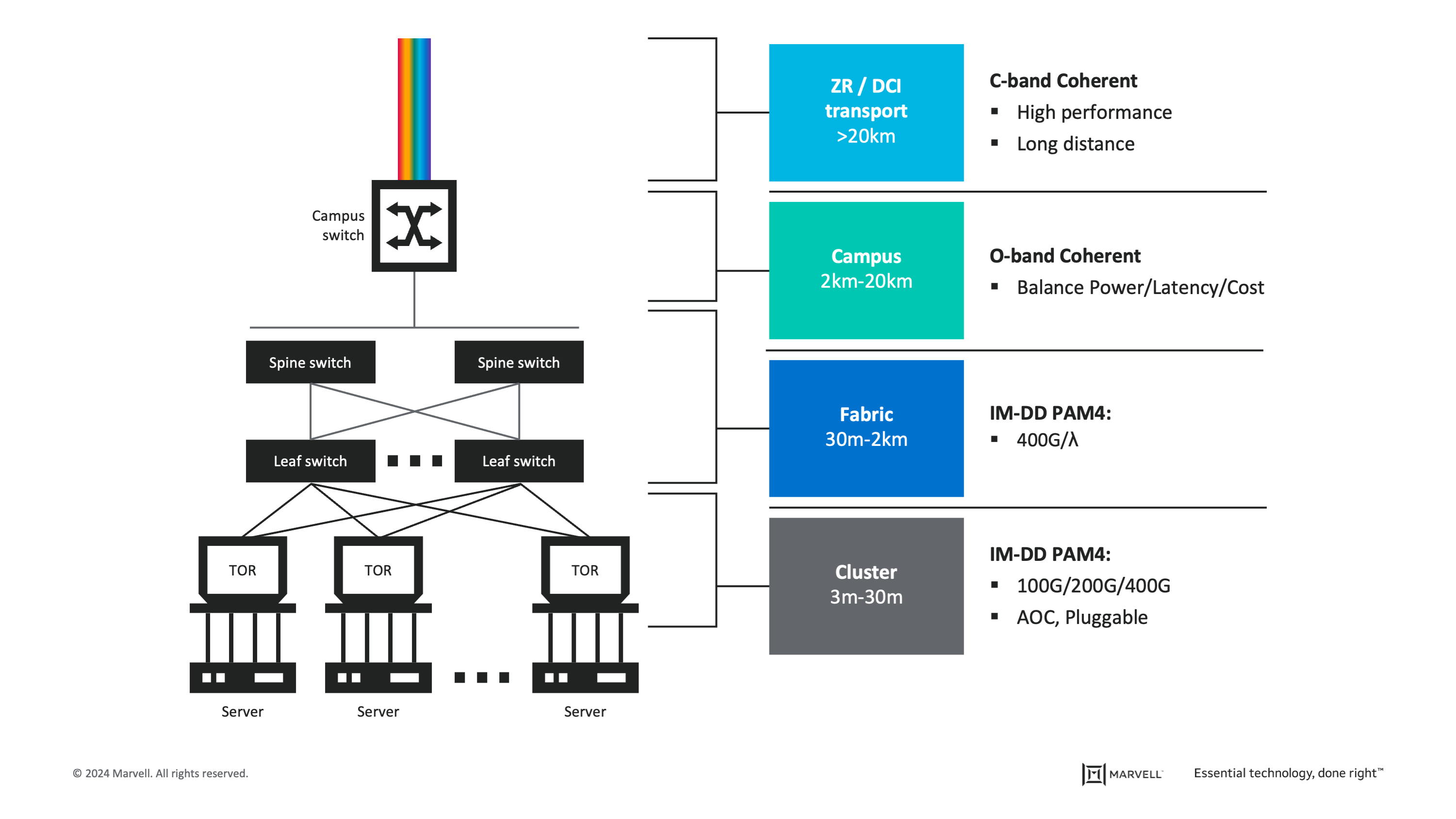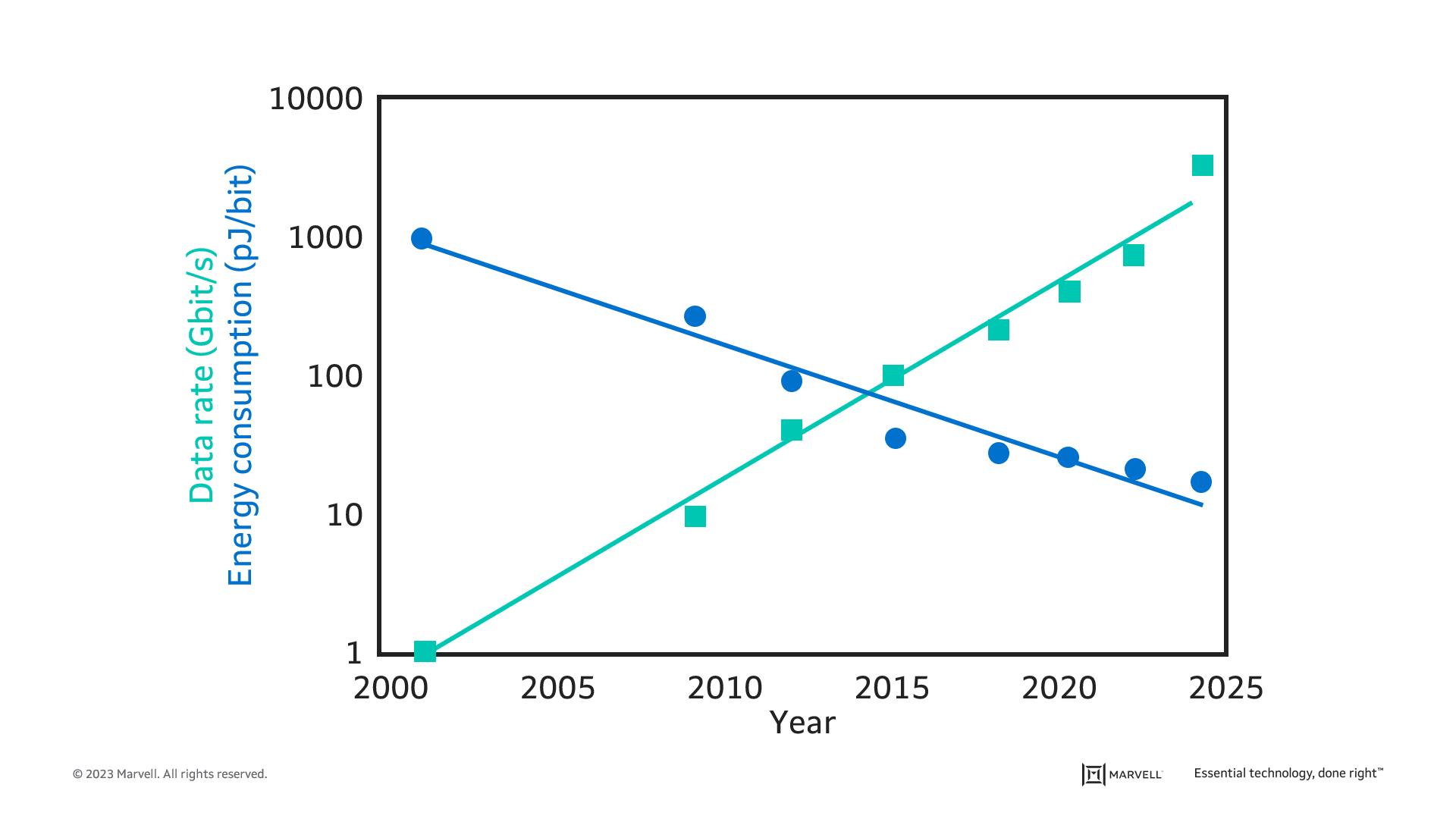

By Xi Wang, VP of Product Marketing of Optical Connectivity, Marvell
Over the last 20 years, data rates for optical technology have climbed 1000x while power per bit has declined by 100x, a stunning trajectory that in many ways paved the way for the cloud, mobile Internet and streaming media.
AI represents the next inflection point in bandwidth demand. Servers powered by AI accelerators and GPUs have far greater bandwidth needs than typical cloud servers: seven high-end GPUs alone can max out a switch that ordinarily can handle 500 cloud two-processor servers. Just as important, demand for AI services, and higher-value AI services such as medical imaging or predictive maintenance, will further drive the need for more bandwidth. The AI market alone is expected to reach $407 billion by 2027.
O-band coherent or coherent lite—a technology that has been discussed for years at conferences but has yet to be deployed commercially in a meaningful way--will likely begin to percolate into the market over the next few years to help cloud service providers accommodate some of these challenges.

By Radha Nagarajan, SVP and CTO of Optical Platforms, Marvell
This article was first published by Photonics Spectra
The cloud. It evokes an ethereal, weightless environment where problems get whisked away by a breeze.
In reality, the cloud consists of massive industrial buildings containing millions of dollars’ worth of equipment spread over thousands, and increasingly millions, of square feet. In Arizona, some communities are complaining that cloud data centers are draining their aquifers and consuming far more water than expected1 while in the UK and Ireland the power requirements of data centers are crimping needed housing development. Even in regions like Northern Virginia where the local economies are tightly bound to data centers, conflicts between residents and the cloud are emerging.
With the rise of AI, these conflicts will escalate. AI models and data sets are growing exponentially in size2 and developers are contemplating clusters with 32,000 GPUs, 2,000 switches, 4,000 servers and 74,000 optical modules3. Such a system might require 45MW of power capacity, or nearly 5x the peak load of the Empire State Building. This resource-intensiveness also shows how AI services could become an economic high wire act for many.

Performance up, Power Down: Over 20 years, the data rate of optical modules has increased by 1000x while power per bit has decreased by 100x.
By Kristin Hehir, Senior Manager, PR and Marketing, Marvell

Marvell is excited to announce that three of its high-speed optical connectivity solutions have been distinguished among the best in the industry by the 2024 Lightwave Innovation Reviews. The three awards validate Marvell leadership in PAM4 DSP, coherent DSP and data center interconnect (DCI) modules for accelerated infrastructure.
A panel of judges, comprised of experts from the optical communications community, awarded Marvell with the highest score possible of 5.0 for both its Nova 1.6 Tbps PAM4 electro-optics platform and COLORZ® 800 ZR/ZR+ pluggable module, and an outstanding 4.5 honoree status for its Orion 800 Gbps coherent DSP. The honors reflect the industry’s recognition of Marvell leading-edge technologies to address the growing bandwidth and connectivity needs of artificial intelligence (AI), cloud data center and carrier networks.
Lightwave Editor In Chief Sean Buckley expressed his congratulations, stating, “On behalf of the Lightwave Innovation Reviews, I would like to congratulate Marvell on achieving a well-deserved level honoree status. This competitive program enables Lightwave to showcase and applaud the most innovative products, projects, technologies, and programs that significantly impact the industry.”
By Rohan Gandhi, Product Marketing Manager, Optical and Copper Connectivity
When the London Underground opened its first line in 1863, a group of doubtful dignitaries boarded a lurching, smoke-belching train for history’s inaugural subway ride. The next day, thirty thousand curious Londoners flooded the nascent system, and within a year, more than nine million had embraced its use. Nearly 160 years later, that original tunnel is still in daily use, joining 250 miles of track that carry more than 1.3 billion passengers annually.
What were the keys to such extraordinary growth? Not just popular demand for more tunnels, but also better use of accumulated infrastructure – optimized through newer trains, enhanced signaling, greater energy efficiency, and smarter scheduling. In a sense, the Tube’s transformation mirrors the fundamental challenge now confronting modern data centers: how to make better use of existing infrastructure to handle today’s exponential growth of data.
PAM4 DSP Technology is Fast and Flexible
To keep up with the surging data demands of new video and AI workloads, modern data centers can’t simply add more and bigger pipes – at least not cost-effectively. They need PAM4 based optical module solutions to effectively and efficiently move more bandwidth at higher speeds. In addition, they need to be able to update the optical modules via software, optimizing existing infrastructure at an affordable price.
Copyright © 2025 Marvell, All rights reserved.
